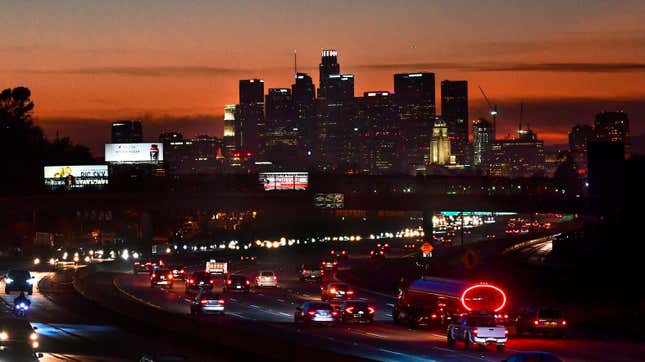
After five consecutive years of decreasing greenhouse gas emissions, California saw an increase in its planet-warming pollution. That’s according to a new report from the nonprofit Next 10 and research firm Beacon Economics.
The analysis shows that California could get back on track with climate policy by investing in a green stimulus. It also contains important lessons for national climate policymakers, including the fact that unfettered growth in the commercial real estate industry is incompatible with meeting climate targets.
The 12th annual California Green Innovation Index, released early Tuesday morning, shows that the state’s emissions increased by 830,000 metric tons of carbon dioxide-equivalent in 2018, representing a 0.2% increase from the previous year. This will make it harder for officials to meet the state’s legal mandate to reduce emissions 40% below 1990 levels by 2030. To reach that goal, California now must lower its emissions by an average of 4.9% each year from 2020 to 2030.
The biggest contributor to the jump was the commercial sector, which includes all business establishments besides manufacturing, like restaurants, retailers, and hotels. Growth there produced 2.7% more climate-changing emissions in 2018, the largest increase of any area of California’s economy. Its climate impact has been steadily increasing for decades, shooting up 69.3% from 2000 to 2018.
It wasn’t the carbon footprint of building materials that drove the rise, but the sector’s use of HVAC and refrigeration technologies. Hydrofluorocarbons and perfluorocarbons, a highly potent class of greenhouse gas used in fire protection, solvents, and refrigeration and air conditioning activities, were a huge problem. These chemicals, especially in the commercial sector, are now the fastest-growing source of global warming pollution in California, making up 4.7% of total statewide emissions in 2018. That’s quadruple the portion they made up in 2000.
The backslide on the state’s climate goals came despite reductions in carbon pollution from the state’s transportation sector. Transit saw a 0.9% reduction in greenhouse gas emissions in 2018, which is a feat since the sector’s emissions had slowly crept upwards in previous years.
“The fact that transit emissions went down is significant,” Colleen Kredell, director of research at Next Ten who worked on the report, said, noting it shows the state’s efforts to rein in those emissions in particular “are having an impact overall.”
But transit still made up the largest share of the state’s carbon pollution at 40.9%, producing 174 million metric tons of carbon-equivalent in greenhouse gas—nearly the output of 50 coal-fired power plants—showing this year’s dip is far from enough.
It’s clear California will also have to get a handle on the commercial real estate sector, including placing more restrictions on expanded refrigerant use. Earlier this month, the state recently approved a plan to rapidly decrease the use of these harmful chemicals.
But it could be superseded by a new federal plan taking shape. On Monday, the Senate agreed to include a plan to massively ramp down the country’s production and use of HFCs, which have up to 11,700 times the warming potential of carbon dioxide. That would still leave the state to deal with perfluorocarbons.
Overall, the report’s authors show that for California to meet its climate goals, it will have to massively increase its reductions in greenhouse gas pollution across all sectors. From 2015 to 2018, the state reduced its output by 1.18%. “Assuming that same three-year average rate of reduction...California needs to quadruple the rate of reduction to achieve the 2030 goal and ramp up that rate of reduction even more to achieve the 2050 goal,” the report says.
To meet that goal, the researchers say policymakers should pour funding into a climate-focused economic stimulus package, which could invest in decarbonizing every sector of the economy.
“There’s no one magic silver bullet. We’ll need a variety of programs,” Hoyu Chong, a lead researcher at Beacon Economics and report co-author, said. “And we not only want to have effective roadmap for decreasing emissions, but at the same time we also, we also want to create other economic benefits in the recovery from economic recession.”
The authors say this stimulus package could include $23.1 million for a Los Angeles clean ride-sharing program to cut transit emissions, $70.8 million for a program to protect agricultural lands against conversion to more carbon-intensice industries, and $11.4 million in funding to a weatherization program for low-income housing with energy efficiency upgrades and solar installations.These projects could also generate revenue for the state and create hundreds of much-needed jobs, as could increased investments in the renewable energy sector. Federal policymakers should heed that call, too.